

Site Search
Search within product
第763号 2024(R6) .08-09発行
Click here for PDF version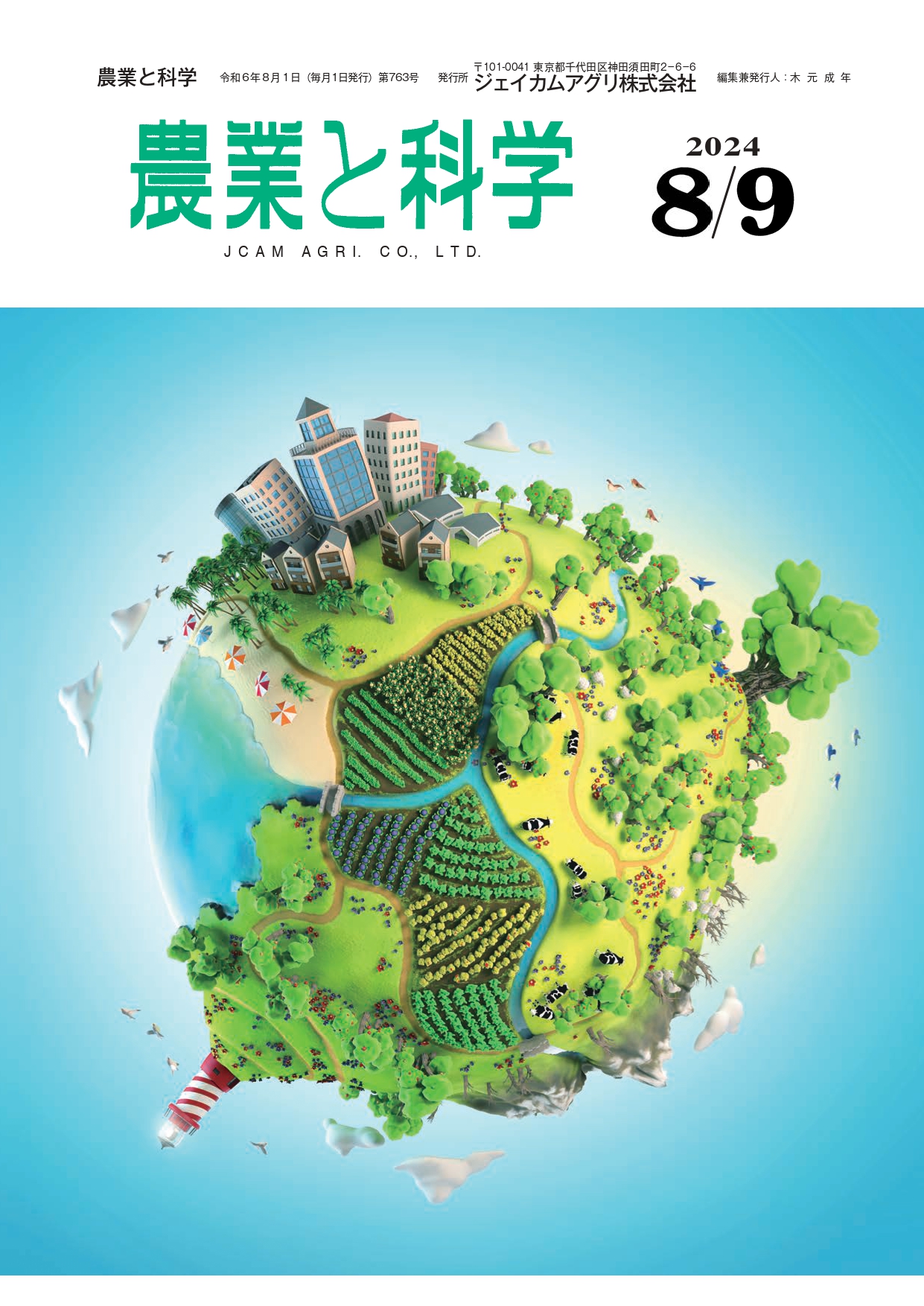
農業と科学 令和6年8-9月
本号の内容
§日本ナシ「幸水」に対する根域施肥と
表面局所施肥を組み合わせた50%減肥技術
Cultivation Department, Nagano Prefectural Nanshin Agricultural Experiment Station
技師 塩原 孝
§テレビ番組〈満天☆青空レストラン〉にみる
付加価値を意識した作物生産について
-果菜類・豆類編-
Miyagi University, School of Food Science and Industry
齊藤 秀幸
§土のはなし-第34回
危機に瀕する世界の土-その4
侵食による土の劣化
前 ジェイカムアグリ株式会社
北海道支店 技術顧問
松中 照夫
Root zone fertilization of Japanese pear "Kosui" and
表面局所施肥を組み合わせた50%減肥技術
Cultivation Department, Nagano Prefectural Nanshin Agricultural Experiment Station
技師 塩原 孝
Introduction
The general method of fertilizer application in fruit tree cultivation is the total surface fertilization method. This method is based on the premise that the rooting zone, which absorbs nutrients and water, is widely distributed throughout the garden area, and the fertilizer is applied to the entire surface of the garden area or is mixed with the soil by plowing the surface very shallow after fertilization.
However, the utilization of fertilizer by tree bodies in this fertilization method is said to be about 20 to 30% when the orchard is under clean tillage management and only 1% under grass management. In addition, the assumption that roots are spread over the entire field is not certain in recent orchards, where the soil has become denser due to the driving of pest control machines and other heavy machinery.
On the other hand, local application of fertilizer in the vicinity of the crop roots increases the absorption and utilization of fertilizer, thus making it possible to reduce fertilizer use. In the past, local fertilizer application was done by digging trenches in the shape of an octopus, horseshoe, or radiating from the main trunk by hand or machine (backhoe or trencher) and applying fertilizer to the trenches. However, this method is rarely used today due to labor and other reasons.
In this study, we examined a fertilizer reduction technique for Japanese pear "Kosui" that combines a simple root zone fertilizer application using a compressed air injection soil conditioner and a localized fertilizer application to the soil surface.
2. soil improvement by compressed air injection type soil conditioner
最初に,今回検討した局所施肥技術の基礎となる圧縮空気噴射式土壌改良機による土壌改良技術について概略を紹介する。
In the field, there are many orchards with dense soils that have not been improved by deep tillage. The aforementioned trenching for fertilizer in the shape of a trestle, horseshoe, or radius, which itself doubles as deep tillage, is no longer used due to lack of labor, excessive root breakage, and concern about the spread of white crest feather disease.
そこで,当試験場では,日本ナシ「幸水」(2000~2002年)及びカキ「市田柿」(2012~2015年)に対して,専用機器を用いて圧縮空気を噴射させ,土壌硬度を低下させる簡易な土壌改良方法の実証試験を行った。
The equipment used was a compressed air injection soil conditioner (product name: Growth Gun GR1000, manufactured by Mack Engineering Co. The nozzle is inserted into the soil and a jet of compressed air is injected from the tip of the nozzle.
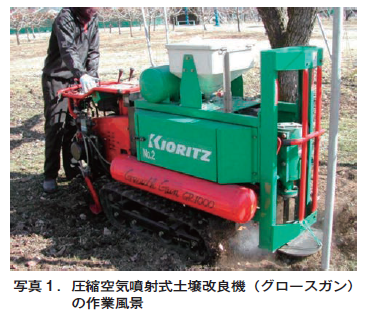
The depth that can be improved is 50 to 60 cm, and the horizontal extent is 40 to 60 cm in radius centered on the nozzle insertion point. The duration of the hardness reduction effect was observed to be about 9 months for heavy fine yellow soil.
The effect of the growth and yield of the pear trees treated with the growth gun was not discernible over the two-year test period, but an increase in fine root mass was observed. For oyster trees, yields increased and root activity tended to be higher from the third year of the trial (data omitted).
3. 50% fertilizer reduction technology by combining root zone fertilization with local surface fertilization using a growth gun
The growth gun can dispense granular fertilizers and soil improvement materials simultaneously with compressed air injection. Therefore, a localized fertilizer application technique that combines soil improvement and fertilizer application was investigated.
In this fertilization technique, a growth gun is used to improve the soil around the main trunk of the pear tree in late February, just before the roots begin to grow (Photo 2 and 3), and at the same time, base fertilizer is applied to the root zone of the tree (root zone fertilization). This is a technique (Photo 4).
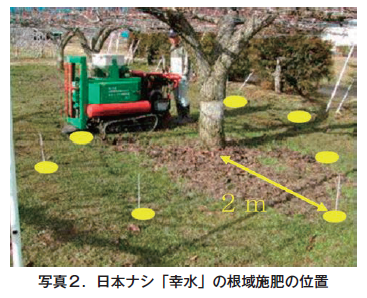
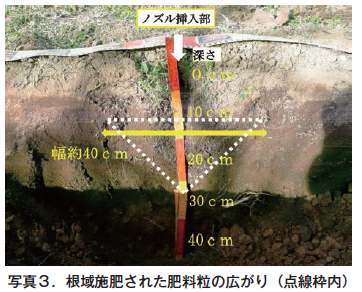
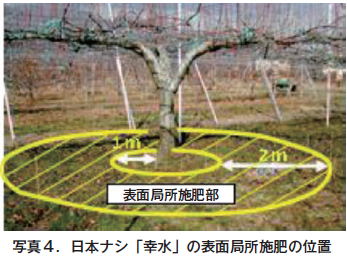
(1) Testing Method
The test was conducted for five years (2018-2022) in the field (560 m elevation, light-colored black soil) at the Nanshin Agricultural Experiment Station. The test trees were Japanese pear "Kosui" mature trees (40 years old at the beginning of the trial, three main branches in an improved eclectic style with a flat trellis). The planting interval was 8.0 m x 7.2 m, the planting density was 16 trees/10a, and the test scale was 3 trees per plot with no replications.
The test plots were a combination of root zone fertilization with a growth gun and local surface fertilization (hereafter referred to as "root zone fertilization") and a control plot that roughly corresponded to the local practice (Table 1).
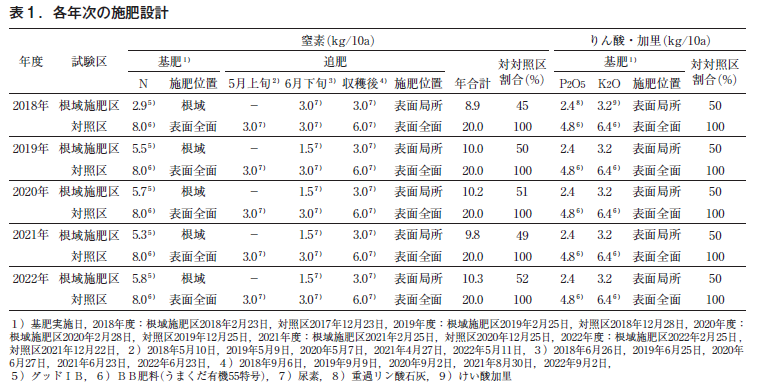
In the control plot, fertilizer was applied four times a year: base fertilizer (December), additional fertilizer 1 (early May), additional fertilizer 2 (late June), and a courtesy fertilizer (immediately after harvest), for a total annual nitrogen application of 20 kg per 10 a, consisting of 8.0 kg of base fertilizer + 3.0 kg in early May + 3.0 kg in late June + 6.0 kg of courtesy fertilizer. The fertilizers used were BB fertilizer (10-6-8) containing organic matter for the basal fertilizer and urea for the supplementary fertilizer and courtesy fertilizer. Fertilizer was applied to the entire surface of the garden area at all times.
In 2018-2020, the control plot received only compressed air impoundment treatment at the same location as the root zone fertilization plot to have the same effect of soil improvement, but in 2021-2022, no compressed air impoundment was applied and no treatment was applied.
In the root zone, Good IB (isobutyraldehyde condensed urea, 33% total nitrogen content) was injected into the soil at a depth of 30 to 40 cm at eight equally spaced locations around a distance of 2 m from the main trunk in late February (Photos 2 and 3). The actual amount of nitrogen fertilizer applied was about 5.5 kg/10a at a planting density of 16 plants/10a, which was about 50% of the total amount of 11.0 kg of base fertilizer and 1 additional fertilizer applied in early May in the control area, although the amount varied from year to year. The growth gun was a leased machine owned by a local JA.
The fertilizer was applied locally on the surface with urea at 50% of the nitrogen level of the control (1.5 kg in late June and 3.0 kg after harvest) in a 2 m wide ring starting 1 m away from the main trunk (Photo 4).
Annual nitrogen fertilizer application in the root zone was about 10 kg/10 a, about 50% of the local practice.
なお,試験1年目の2018年度は,グロースガンで処理した基肥の実測量が想定より少なくなったため,6月下旬の窒素追肥量を対照区と同量の3.0kg/10aとした。また,リン酸と加里は,根域施肥直後に単肥(重過リン酸石灰,ケイ酸加里)を用いて写真4に示す位置に慣行施肥量の50%を表面局所施肥した。
(2) Nitrogen leaching progress of Good IB fertilized in the root zone
Good IB leached 20 to 30% of nitrogen within 3 weeks after root zone application, indicating its effectiveness as a basal fertilizer. Thereafter, the leaching process differed from year to year, but approximately 20% of nitrogen was leached during the two-month period from late April to late June in each year, which was equivalent to the effect of fertilizer application 1 in early May in the control area (Figure 1).
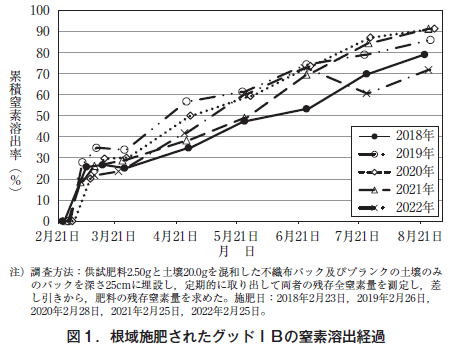
(3) Effect on tree growth, etc.
(1) New shoot growth
Except in 2020, the third year of the trial, there were no significant differences in shoot growth between the root zone fertilization and control treatments (Table 2).
2020年は,対照区が根域施肥区よりも樹冠1㎡当たりの全新梢長及び平均長が根域施肥区より有意に長かったが,これは試験ほ場の根域施肥区の暗渠の排水機能が不十分だったことにより,6~7月に多量降雨後の園内滞水時間が長くなり,新梢伸長が早期から抑制されたためと考えられた。

(2) Percentage of flower buds on stems
No significant differences were observed between the root zone fertilization and control treatments for both reserve branch tip shoots and latent bud development shoots, except for latent bud development shoots in 2019 (Table 3).

(3) Three-element content in leaves
The nitrogen content of the midleaves of long-fruiting branches without fruit set did not differ except for a significant difference between the root zone fertilization and the control in August 2019, the second year of the trial, and no constant trend was observed (Table 4).
Significant differences in phosphoric acid content were observed in late June 2020, the third year of the study, and in potassium content in late June 2018, June 2021, and July 2022, the first year of the study, but not at other times or years and no consistent trend was observed (Table 4).

(4) Root volume after 3 and 5 years of testing
Root volume at a distance of 2 m from the main trunk was examined after defoliation. In 2020, the third year of the trial, both sites were treated with compressed air injection by a growth gun, and no significant differences were observed between the two sites, but there was a trend toward more fine roots less than 1 mm thick in the root zone where fertilizer was applied, suggesting that more fine roots were found in the vicinity of the Good IB distribution. In 2022, the fifth year of the trial, a similar trend was observed as in 2020, although the difference was not significant (Table 5).

(5) Differences in fertilization methods and grass growth
In the root zone fertilized area, the dry matter weight of the underbrush clippings tended to be lower than in the control area until July in both the 2 m wide ring starting 1 m from the main trunk immediately above the root zone fertilized area and the non-fertilized area outside the ring, suggesting that the underbrush used less fertilizer in the root zone fertilized area (Figure 2).

(4) Influence on fruit yield and quality of "Kosui
樹冠1㎡当たりの果実収量(重量)は,5年間とも根域施肥区と対照区の間に有意な差はなかった(表6)。
In 2020, the third year of the trial, the number of fruit set at harvest was higher in the root zone fertilization area because of frequent fruit breakage due to continuous rainfall in June and July, which forced the mid-harvest stop of corrective fruit picking, resulting in lower single fruit weight in the control area (Table 6). In 2022, the fifth year of the experiment, the fruit weights of the root zone fertilization and control were similar.
Fruit quality (peel color, firmness, sugar content and acidity) at the peak of harvest did not differ between the two treatments during the five years (Table 6).

(5) Effects on soil chemistry
Soil chemistry at the end of growth for each test year is shown in Table 7.

In the fertilized area about 2 m away from the main trunk in the root zone fertilization area, pH (H2O) and exchangeable lime content (CaO) were lower at a depth of 20 to 40 cm in 2020, three years after the test, and pH (H2O) and exchangeable base content (CaO, MgO and K2O) at both 0 to 20 cm and 20 to 40 cm depth in 2022 and exchangeable base content (CaO, MgO, and K2O) were lower in the control and root zone fertilized areas than in the non-fertilized areas. The ammonium ion (NH4+) and nitrate ion (NO3-) generated during the decomposition process of Good IB and urea in the root zone fertilized area may have affected the amount of exchangeable base absorbed by "Soy Water" and the amount of runoff to the lower layers, but further study is needed to determine the details.
No significant differences were observed between the control and root-area fertilized areas and the non-fertilized areas for other items and components.
(6) Expenses related to fertilizer application
Based on the actual fertilizer application in 2020, the third year of the trial, we estimated the annual fertilizer cost per 10 a for the root zone fertilization zone and the growth gun use fee (Table 8).
The total cost of fertilizer and growth gun in the root zone was 12,854 yen, 67% of the 19,123 yen in the control zone. The fertilizer cost in the root zone (7,854 yen) was 56% of that in the control (14,123 yen). Even if no growth gun treatment was applied in the control, the total cost of 12,854 yen for the root zone fertilization was 91% of the fertilizer-only cost of 14,123 yen in the control.

4. at the end
A combination of root zone fertilization with soil improvement and localized surface fertilization in a ring around the main stem just above the root zone fertilization was applied to Japanese pear "Kosui" using a compressed air injection soil conditioner (Growth Gun). Growth, yield, and fruit quality were maintained at the same levels as conventional fertilizer application.
Although the proportion of expenses related to fertilizer application is small in fruit tree management, this fertilizer application technology is considered to be a positive management technique under the recent situation of high fertilizer prices. In addition, this technology can contribute to the reduction of chemical fertilizers as indicated in the "Green Food System Strategy.
TV program "Manten☆Aozora Restaurant
付加価値を意識した作物生産について
-果菜類・豆類編-
Miyagi University, School of Food Science and Industry
齊藤 秀幸
Introduction.
By chance, I supervised 12 programs of the gourmet variety show "Manten☆Aozora Restaurants" (Nippon Television Network Corporation) from 2022 to 2023. The program airs every Saturday from 18:30 to 19:00, with MC Daisuke Miyagawa traveling around Japan and introducing interesting local ingredients and dishes using them with guests. The program covers a wide variety of items, including vegetables, marine products, livestock products, grains, and more. In the case of vegetables, the program first takes viewers on a tour of the fields where they are actually grown and introduces the ingenuity and persistence of the growers in their cultivation, while MC Miyagawa and the guest of the day perform the harvesting process, giving a realistic feel to the program. The role of the program supervisor (myself) is to supervise the ingenuity and persistence of the growers from a horticultural perspective. The approximate flow of the program is as follows: First, before the production staff visits the site, the program supervisor (me) confirms with them the background knowledge necessary for the interview. Next, the program supervisor (me) examines the validity of the information obtained through the interviews together with the production staff, and then checks the contents of the message, video clips, etc. for errors. In doing so, I try to eliminate technical terms and use easy-to-understand expressions as much as possible, but it is not an easy task. In principle, communication is done by e-mail. In such cases, although they are not necessarily broadcast, the production staff may ask for scientific evidence, and it is sometimes necessary to check previous studies. I can't write about specifics, but it is like answering questions in a written exam. The program is sold on the light-hearted exchanges between Mr. Miyagawa, the MC, and the guests, and on its fast-paced flow, but the content on cultivation, plant properties, and nutritional value is carefully examined, and I strongly felt the seriousness of the production attitude when I was involved in the program. I personally learned a lot from the program, but it was also interesting as an example of value-added production.
In this paper, I would like to look back on each of the programs I supervised from the viewpoint of a program supervisor, mention the points that impressed me, and consider value-added production of crops, especially vegetables. Since I do not have much to say about the latter half of the program, I would like to focus on the first half of the program, which is about cultivation. Incidentally, in supervising the program, we are not informed in advance of the names of the producers (organizations) and guests, nor are we informed of any other program supervisors, if any. The information is provided blindfolded as much as possible, and objectivity is fully guaranteed. The name and affiliation of the supervisor appears in a message at the end of the program, so if you have a chance, please take a look. My impression is that many of them are local universities and research institutes. I believe that the reason I was chosen to supervise the program beyond the region was because of the high evaluation of the various crops and varieties that we have tried at our farm affiliated with the Faculty of Food Science and Industry of Miyagi University. In this paper, I will review fruit and vegetable crops and legumes, and in the next paper, leaf and stem vegetables, root crops, and fruit trees, in that order.
Saga Prefecture, Western Eggplant (broadcast Aug. 13, 2022)
The town of Yoshinogari-cho, Kanzaki-gun, Saga Prefecture, where the program was set, is famous for the Yoshinogari Ruins, which are designated as a special national historic site (Saito, 2023). At the Yoshinogari Ruins, large-scale moat encircling settlements of the Yayoi period, symbolized by rice cultivation, have been discovered. The cultivation of "Western" eggplant in this area, which has a strong flavor of ancient Japan, is an interesting contrast.
舞台となった農場の特徴は,
①標高が260mと比較的高地にあり,昼夜の気温差が大きいこと,
②日本には珍しく,アルカリ性の中硬水地域であること
である(齊藤,2023)。果菜類の果実肥大には,当然ではあるが,光合成が大きく影響すで促進される。しかし,最近,日本各地において大きな問題となっている35℃以上の猛暑では,ナス等の暑さに強い性質の作物でも体力を奪われる。その点,番組の舞台となった圃場は高地にあり,過酷な高温にはなりにくいとのことであった。そして,葉から果実への光合成産物の転流は,夕方以降,急速に気温が下がることで促進される。いわば天然の変温管理が行われているといえる。ところで,ナス果実の水分は90%を超える。水分が多いだけに,栽培における水質は重要な要素である。日本の河川の場合,急流が多いため,各種ミネラルが川に溶け込む時間が短く,一般的に軟水である。その点,当地域の水質は比較的ヨーロッパ(硬水)に近いといえる。このように当地では高度や水質といった地理的な条件を活かした付加価値栽培が行われているといえる。
In addition, the growers who appeared in the program grow about 30 varieties of eggplants from around the world (Saito, 2023). The program introduced mainly "Violetta di Firenze," "Dancer," "Macua Po," and "Casper" among them (Saito, 2023). This large number of cultivars is another selling point of the farm.
Violetta di Firenze" is a huge round eggplant (Saito, 2023). It is often eaten in Italy and is considered the king of eggplants. It is less widely distributed in Japan, and the price per fruit is about four times higher than that of a common eggplant. Its shape is similar to that of a tomato. Its texture becomes tender when heated.
Dancer" is a beautiful looking eggplant (Saito, 2023). It is often eaten in Puerto Rico in Central and South America. In the program, it was introduced that the fruit is the most delicious. It is an eggplant with a fairly high sugar content. One reason for this may be that the first fruits have few rivals competing for nutrients.
Makua Po" is a variety commonly eaten in Thailand (Saito, 2023). Eggplant is called "makua" in Thai. In Japan, it is known as "Tamago nasu" (eggplant). It is a small green round eggplant. It is green because it lacks the anthocyanin pigment nasunin. In Japan, the color purple is associated with eggplant, but overseas, green and white eggplants are more common than in Japan. The fruit is quite firm, but softens when heated.
Caspar" is a white long eggplant commonly eaten in France (Saito, 2023). The production staff asked me about the origin of the name of the variety. Although there is no proof, I answered that it may have been named after Caspar (a ghost character in an anime) because of its resemblance. The program introduced this point as "there are various theories," and I felt that they made an appropriate judgment. It was a moment when I felt the program was sincere in its production. Bananas are characterized by their thin skin, soft fruit, and low acidity. In the program, it was introduced as resembling a peeled banana, and it was introduced as resembling a banana.
The producers seemed to receive more than 500 orders per month from restaurants to individuals (Saito, 2023). They were also active in exploring cooking methods that brought out the potential of each variety. The fact that they are exploring cooking methods from the viewpoint of food ingredients, rather than just production, is a characteristic of this program. However, this attitude was common to all the producers introduced in the program.
In a word, the farm itself seemed to be adding value by planting many varieties.
Ishi Doufu, Gifu Prefecture (aired May 20, 2023)
The setting is Shirakawa Village, Ono-gun, Gifu Prefecture. The "Gassho-Zukuri Villages" of Shirakawa-go and Gokayama are registered as a World Heritage site. Ishi Tofu was featured as a traditional ingredient that preserves the flavor of the past. It is said to be one of the firmer tofu types and does not lose its shape. The area is famous for its heavy snowfall, and the tofu was developed as a preserved food for winter. The hardness of the tofu is what makes it so satisfying to eat. Since he was not a specialist in the area of eating quality, he asked his colleague, Assistant Professor Takashi Akazawa (Department of Food Protein Science, now at Niigata University), to co-supervise the research.
The raw material was Enrei soybeans grown in Toyama Prefecture. It is considered to have a sweet, unctuous, and straightforward taste, and its high protein content makes it suitable for tofu, which is made by firming protein. I supervised the broadcast on the characteristics of this variety. It was characterized by the use of two to three times the amount of soybeans as compared to ordinary tofu and the use of spring water that comes from the mountains. The use of this water, which has less cloying taste, gives the tofu a good aroma and allows the true flavor of the soybeans to be tasted. The key point is to take more time than in the general production process and to drain the water thoroughly.
Although the supervision of the cultivation was small, we were very happy to have jointly supervised the cultivation within the School of Food Science and Industry of Miyagi University.
Tomatoes, Kanagawa (aired May 27, 2023)
舞台となったのは神奈川県茅ヶ崎市である。トマトはリコピンやビタミンEが豊富で体や肌の老化を抑える効果が期待できるとされる。案外知られていないことであるが,トマトの出荷量は5月が最も多い。そこで現代の「旬の時期」は5月とした。栽培品種は‘湘南ポモロン’である。一般的にはあまり耳にすることのない品種であるが,神奈川県の農業技術センターで育成された品種である。出演の生産者は2016年から作付けしている。先の尖った独特の果形であり,肉厚でジューシーである。生食でも美味しく,熱を加えた調理で型崩れしにくいのが特徴である。加熱することで旨味と甘みがアップする。日本は生食がメインであるが,海外では加熱して調理・加工するのが通常である。加熱しても水っぽくならない点が利点である。品種名に使われているポモロンはイタリア語でトマトを表すポモドーロと英語のロング(果形が細長いので)を合体させたネーミングである。細長いイタリア系のトマトと日本で育成された愛知ファーストを交雑して育成した中玉品種である。概して生食用の品種では果実が柔らかくジューシーで甘みが強いのに対して,加工用の品種では完熟させて収穫するので,果実は果肉が厚く,水分が少ない。加工用の果実では旨味は濃いが酸味も強く,生食には向かない。加工用は加熱することで酸っぱさが旨味に変わるとのことである。神奈川県農業技術センターによれば,湘南ポモロン・レッドは一般的な品種に比べてリコピンの含有量が1.5倍,β-カロテンの含有量が2.2倍であるという。番組では湘南ポモロン・ゴールドも紹介された。オレンジ色の品種であり,サラダの彩りに使われる。酸味は控え目でフルーティーな味わいで食べやすいとのことであった。
In a word, it is suitable for both fresh eating and cooking, and the farm itself seems to have added value by using unusual varieties with distinctive fruit shape and taste.
Tokyo Butternut Pumpkin (aired September 2, 2023)
The setting was Hachioji City, Tokyo. In the opening, it was mentioned that there are unique pumpkins all over Japan, and 'Susuna Kabocha' (Takayama City, Gifu Prefecture) and 'Utsugi Akagawa Amaguri Kabocha" (Kanazawa City, Ishikawa Prefecture) were introduced. All of them have unique shapes and colors, but the "Butternut Pumpkin" was introduced as a pumpkin that is as unique as any of them (Photo 1). The buttery smoothness and nutty flavor of this pumpkin were repeatedly introduced as attractive. It has a unique gourd shape.

Butternut pumpkins are said to have originated in the United States in the 1940s and were first imported to Japan 46 years ago in 1977. Although it was not mentioned in the program, butternut pumpkin was branded as a disqualified product by the marketers at that time because it did not have the crunchy texture that the Japanese like. Today, however, its value is being recognized. It is a kind of "revival of the underdog," so to speak, as its value has risen with the changing times.
On the other hand, in discussions with the production staff, the theme was why the unique gourd-shaped form shown in Photo 1 was obtained. In butternut pumpkins, the seeds are unevenly distributed in the gourd-shaped bulge. It is well known that auxin secretion from the seeds promotes the enlargement of the pulp around the seeds inside the seedlings, but we sought to create an easy-to-understand expression for the general public. In the program, a movie was made, and the closer to the seed, the more strongly the pulp wraps around the seed and the more it enlarges. This was a point of great difficulty. After discussions, it was also decided that the swollen part of the fruit would be sweeter because "nutrients for seed growth are concentrated in the swollen part.
Fortunately, we were also growing butternut pumpkins at the Tsubonuma Farm attached to Miyagi University, where I work.
The sweetness of the grapes increases during this period as the starch is converted to sugar, which is another point that was supervised. After ripening, the squash can be eaten raw, and when the MC and guests actually tried it raw, the sweetness and texture like oysters and the nutty aroma were emphasized. Even though it did not have the characteristic crunchiness of pumpkin, the "moist texture" that enhanced its deliciousness was emphasized, and the negative evaluation in 1977 was turned into a positive one.
After mentioning that the sweetness and texture become more pronounced when heated, we moved on to the second half of the cooking session. We started by baking the whole potatoes as they were. In that case, the effect of far-infrared radiation (increased sweetness) was emphasized as in the case of baked sweet potatoes, and although this point was not broadcasted, the scientific basis was confirmed. According to the guest, the taste was similar to that of sweet potatoes, with no fibers and a smooth texture. The dish was also used in potage, pudding, keema curry, and various other applications.
The producer of the show produces 80 to 100 kinds of pumpkins a year, including green eggplants and round okra, and the butternut pumpkin is one of them.
The first time I saw a new building, I was surprised to see it.
In a word, the farm itself seemed to add value in that it could meet all needs by producing many unusual vegetables.
(The following sections - leaf and stem vegetables, root vegetables, and fruit trees - will be continued in the next issue.)
No Soil - No. 34
危機に瀕する世界の土-その4
侵食による土の劣化
前 ジェイカムアグリ株式会社
北海道支店 技術顧問
松中 照夫
Following the previous three articles, the soil degradation discussed in this article is the damage caused by erosion. There are two types of erosion. One is water erosion, in which the topsoil is eroded from the surface by water, and the other is wind erosion, in which the topsoil is eroded by wind. This erosion is the most serious damage to soil in the world.
1. History of Soil Deterioration
The concept of "sustainable development," or development that satisfies the needs of future generations while also satisfying the needs of present generations, first appeared in 1987. This concept was presented in the final report "Our Common Future" issued by the World Commission on Environment and Development (abbreviated as the Brundtland Commission after its chairman), which was established by the UN General Assembly in 1984. The Commission's problem was that "economic growth and development are necessary to solve problems such as the world's population explosion and poverty. However, if this leads to environmental destruction and resource depletion, sustainability will be lost. Therefore, the conclusion was that "sustainable development" was the key to solving these problems.
The resource that attracted the most attention in the wake of this environmental destruction and resource depletion was soil. At the time, soil degradation was already being viewed as a problem, and in particular, claims were beginning to emerge that soil erosion would undermine the future prosperity of humankind. However, there was no concrete evidence to support such claims as to where and how much soil degradation was serious and where it was not, or what the causes of soil degradation were. To gather supporting information, at about the same time as the Brundtland Commission's final report was issued, the United Nations Environment Programme (UNEP) launched a three-year project (1987-1990) with the International Soil Information Center (ISRIC) called "Global Assessment of Soil Degradation (GLASOD)".
2. type and area of soil deterioration
Many soil scientists from around the world participated in GLASOD, which covered approximately 13 billion hectares of the world's land area, and investigated the causes, types, extent, and degree of degradation. The results were published in 1991 as a map of the world at a scale of 1:10 million according to the type of degradation. The results for the area are shown in Table 1 (Oldeman et al., 1991).
Table 1 shows that 15% of the world's land area, or 1.96 billion hectares, was degraded by anthropogenic factors. The anthropogenic factors that contribute to soil degradation have already been described in the June issue of this series (Vol. 32). The main factors are inappropriate over-cultivation, overgrazing, and excessive deforestation.
GLASOD classifies degradation into four categories according to its status: water erosion, wind erosion, chemical change, and physical change. Of this total, 84%, or 1.64 billion ha, was soil erosion damage. Water erosion accounted for 1.094 billion hectares, and wind erosion for 548 million hectares. It is clear that the cause of soil degradation in the world at that time was erosion triggered by anthropogenic factors.
It should be noted that salinization accounted for only 0.76 billion ha of soil degradation at that time (Table 1). However, as previously mentioned, in 2015, 830 million ha were salinized worldwide (FAO, 2015), showing the tremendous progression of salinization from the end of the 20th century to the present.

3. natural and accelerated erosion
Soil erosion damage caused by human factors is often triggered by improper soil management. Even in the absence of such conditions, topsoil gradually moves downward on sloping land. This is called natural erosion and is a natural process that produces fertile lowland soil.
However, when the vegetation covering the ground is artificially removed and the land is converted to arable land, the soil erosion rate intensifies hundreds of times faster than natural erosion. This erosion influenced by human activities is called accelerated erosion. Compared to natural erosion, the damage caused by accelerated erosion is much greater. A study conducted shortly after the establishment of the U.S. Soil Conservation Service in 1935 (Bennett, 1939) showed that cotton cultivation, with its large exposure of topsoil, causes the greatest erosion damage and that land use as grassland is best for control (Table 2). This is because grasses cover the soil and prevent accelerated erosion.

4. erosion and salinization damage observed in Central Asia
The history of soil degradation caused by erosion is long. In particular, the U.S. experienced large-scale erosion damage three times from the period of western settlement to the 1930s, and the Soil Conservation Service was established in the Department of Agriculture based on lessons learned from this experience. However, soil erosion in the U.S. continues to this day.
Like the United States, Kazakhstan and Tajikistan in Central Asia experienced large-scale wind erosion damage.
In the Forty million hectares of soil, equivalent to 20% of the total arable land in the former Soviet Union, were damaged and degraded. The border area between Kazakhstan and Uzbekistan was converted from steppe to cotton fields under the "Natural Reconstruction Program" of the former Soviet Union. Cotton fields in arid areas require irrigation water, which is drawn from the Amu Darya and Syrdarya rivers, which are fed by snowmelt from the Pamir Plateau and the Tien Shan Mountains. As a result, Uzbekistan ranks fifth in the world in cotton production.
However, as a result, the Aral Sea (about 100 times the size of Lake Biwa), into which the water from both rivers poured, dried up. This is because the water supply to the Aral Sea was cut off by the intake of water from both rivers. The Aral Sea shrank to 10% of its original area and became the Aral Khan Desert. Wind erosion from the desert has scattered 75 million tons of dust and salt containing toxic chemicals annually (Hoshino, 2011). The water taken from the Amu Darya River has been inadequately used, and the soil has become salinated and degraded to the point that cultivation has been abandoned. This is truly the greatest environmental destruction of the 20th century.
